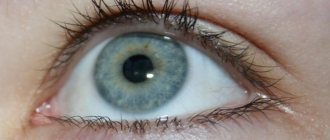Write a review
Reviews: 0
Manufacturers: Alcoy
Active ingredients
- Timolol
Disease class
- Not indicated. See instructions
Clinical and pharmacological group
- Not indicated. See instructions
Pharmacological action
- Not indicated. See instructions
Pharmacological group
- Ophthalmic agents in combinations
Contraindications
The use of eye drops is prohibited if you have a history of the following conditions:
- hypersensitivity to any components of the drug;
- childhood;
- bearing a child and lactation period;
- allergic rhinitis;
- bronchial asthma;
- hyperchloremic acidosis;
- angle-closure glaucoma;
- obstructive pulmonary disease;
- sinus bradycardia;
- heart failure.
If the patient is undergoing surgery in which general anesthesia will be used, Azarga should be discontinued 2 days before the expected date of surgery.
Combined eye drops should be used with caution in the presence of the following pathologies:
- hyperthyroidism;
- diabetes;
- pigmentary and pseudoexfoliative glaucoma;
- Prinzmetal's angina;
- blood flow disturbance;
- decreased intraocular pressure.
Side effects
The active components of the drug can be absorbed into the bloodstream, so systemic side effects may develop. In 10% of cases, the following symptoms may appear:
- development of irritation and pain in the eyes;
- the appearance of a feeling of the presence of a foreign body;
- blurred vision.
In 0.1 – 1% of patients the following symptoms appear:
- clouding or swelling of the cornea;
- dry eyes;
- development of allergic conjunctivitis, redness, itching and burning;
- inflammatory processes in the eyelids;
- increased intraocular pressure;
- decreased visual acuity;
- increased sensitivity to light;
- presence of scleral pigmentation;
- development of dry keratoconjunctivitis;
- double vision;
- increased lacrimation;
- constriction of the pupil;
- apathy;
- sleep disturbance, nightmares;
- development of chronic respiratory diseases;
- a sore throat;
- cough;
- hair loss, in some cases lichen planus develops;
- nervous disorders, depression;
- memory loss;
- drowsiness.
To reduce the risk of systemic absorption, it is recommended to apply gentle pressure on the inner corner of the eye for 2-3 seconds after instilling Azarga.
Azarga in Moscow
Security Profile Overview
The most commonly reported adverse reactions in clinical studies were blurred vision, eye irritation, and eye pain, which occurred in approximately 2–7% of patients.
Below are the adverse reactions noted during clinical trials of AZARGA and its individual components - brinzolamide and timolol. Adverse reactions are listed using the following frequency designations: very often (≥1/10); often (from ≥1/100 to <1/10); uncommon (from ≥1/1000 to <1/100); rare (from ≥1/10000 to <1/1000); very rare (<1/10000) and frequency unknown (cannot be estimated from available data). Within each frequency category, adverse reactions are listed in order of decreasing severity.
Infectious and parasitic diseases:
frequency unknown - nasopharyngitis1, pharyngitis1, sinusitis1, rhinitis1.
From the blood and lymphatic system:
frequency unknown - decrease in the number of red blood cells1, increase in chloride levels in the blood1.
From the immune system:
frequency unknown - anaphylaxis3, systemic lupus erythematosus3, systemic allergic reactions, incl. angioedema3, local and generalized rash3, hypersensitivity2, urticaria3, itching3.
Metabolism and nutrition:
frequency unknown - hypoglycemia3, loss of appetite1.
Mental disorders:
infrequently - insomnia2; frequency unknown - depression2, memory loss3, apathy1, depressed mood1, decreased libido1, nightmares1, 3, nervousness1.
From the nervous system:
often - dysgeusia2;
frequency unknown - cerebral ischemia3, cerebrovascular disorder1, syncope3, increased signs and symptoms of myasthenia gravis
2, drowsiness1, motor dysfunction1, amnesia1, memory impairment1, paresthesia1, 3, tremor1, hypesthesia1, ageusia1, dizziness2, 3, headache2.
From the side of the organ of vision:
often - blurred vision2, eye pain2, eye irritation2; uncommon: - corneal erosion2, punctate keratitis2, effusion in the anterior chamber of the eye2, photophobia2, dry eye syndrome2, discharge from the eye2, itching in the eye1, 2, sensation of a foreign body in the eye2, eye hyperemia2, scleral hyperemia2, increased lacrimation2, conjunctival hyperemia2, erythema century2; frequency unknown - increased optic disc excavation1, choroidal detachment after filtering surgery3, keratitis1, 3, keratopathy1, corneal epithelial defect1, disruption of the corneal epithelium1, increased IOP1, deposits in the eye1, corneal staining1, corneal edema1, decreased corneal sensitivity3, conjunctivitis1, inflammation meibomian glands1, diplopia1, 3, decreased visual contrast1, photopsia1, decreased visual acuity1, 3, visual impairment2, pterygium1, discomfort in the eye1, keratoconjunctivitis sicca1, eye hypoesthesia1, scleral pigmentation1, subconjunctival cyst1, visual disturbance1, swelling of the eyes1, allergic reactions of the eye1 , madarosis1, changes in the eyelids1, swelling of the eyelids2, ptosis3, blepharitis1, asthenopia1, formation of crusts on the edges of the eyelids1, increased lacrimation1.
Hearing and labyrinth disorders:
frequency unknown - vertigo1, ringing in the ears1.
From the heart:
frequency unknown - cardiac arrest3, heart failure3, CHF3, AV block3, cardiorespiratory distress syndrome1, angina1, bradycardia1, 3, heart rate variability1, arrhythmia1, 3, palpitations1, 3, tachycardia1, increased heart rate1, chest pain3, edema3 .
From the side of blood vessels:
infrequently - decrease in blood pressure; frequency unknown - hypotension3, hypertension1, increased blood pressure2, Raynaud's phenomenon3, cold hands and feet3.
From the respiratory system, chest and mediastinal organs:
infrequently - cough2; frequency unknown - bronchospasm3 (mainly in patients with a history of bronchospastic disease), shortness of breath2, asthma1, epistaxis2, bronchial hyperresponsiveness1, laryngeal irritation1, nasal congestion1, upper respiratory tract congestion1, postnasal drip syndrome1, sneezing1, feeling of dry nose1, pharyngolaryngeal pain1, rhinorrhea1 .
From the gastrointestinal tract:
frequency unknown - vomiting1, 3, upper abdominal pain1, 2, abdominal pain3, diarrhea1, 2, dry mouth2, nausea1, 2, esophagitis1, dyspepsia1, 3, abdominal discomfort1, stomach discomfort1, increased peristalsis1, gastrointestinal disorder1, hypoesthesia and paresthesia of the oral cavity1, flatulence1.
From the liver and biliary tract:
frequency unknown - abnormal liver function tests1.
For the skin and subcutaneous tissues:
frequency unknown - urticaria1, maculopapular rash1, 3, generalized itching1, skin thickening1, dermatitis1, alopecia2, psoriasiform rash or exacerbation of psoriasis3, rash2, erythema1, 2.
From the musculoskeletal system and connective tissue:
frequency unknown - myalgia2, muscle spasms1, arthralgia1, back pain1, pain in limbs1.
From the kidneys and urinary tract:
frequency unknown - pain in the kidney area1, pollakiuria1.
From the genital organs and mammary glands:
frequency unknown - erectile dysfunction1, sexual dysfunction3, decreased libido3.
Common disorders:
frequency unknown - chest pain2, pain1, fatigue1, 2, asthenia1, 3, malaise1, chest discomfort1, abnormal sensations1, anxiety1, irritability1, peripheral edema1, 3.
Laboratory and instrumental data:
frequency unknown - increased potassium in the blood2, increased LDH in the blood2.
Description of selected adverse reactions
Dysgeusia (bitter or unusual taste in the mouth after instillation) is a commonly reported systemic adverse reaction associated with the use of AZARGA during clinical trials. This is probably related to brinzolamide and is caused by the penetration of eye drops into the nasopharynx through the lacrimal duct. Occlusion of the tear ducts or gentle closure of the eyelids after instillation may help reduce this effect (see Dosage and Administration).
The drug AZARGA contains brinzolamide, which is a carbonic anhydrase inhibitor and has systemic absorption. Effects arising from the gastrointestinal tract, nervous system, blood and lymphatic system, kidneys and urinary tract, metabolism and nutrition are mainly associated with the systemic action of carbonic anhydrase inhibitors. Similar adverse reactions characteristic of oral forms of carbonic anhydrase inhibitors can also be observed when they are used topically.
When applied topically, timolol enters the systemic circulation, which can cause undesirable reactions similar to those that occur with systemic administration of beta-blockers. The listed adverse reactions include reactions that occur with the use of other beta-blockers in the form of eye drops.
Additional adverse reactions associated with the use of individual active components that are possible when using the drug AZARGA are described above. The incidence of systemic adverse reactions with topical administration is lower than with systemic administration. For information about decreased systemic absorption, see section "Dosage and Administration."
1Adverse reactions observed with brinzolamide monotherapy.
2Adverse reactions observed when taking the drug AZARGA.
3Adverse reactions observed with timolol monotherapy.
Interaction with other drugs
The simultaneous use of Azarga with cardiac glycosides, Guanetedine, and calcium channel blockers is not recommended. This is due to the possibility of slowing heart rate and lowering blood pressure.
Simultaneous use with cimetidine and quinidine leads to the development of bradycardia. The use of Azarga during therapy with carbonic anhydrase inhibitors causes increased side effects.
Combined eye drops are prescribed with caution when treating with Clotrimazole, Treoleandomycin, Itraconazole, and Ketoconazole.
Simultaneous use of Azarga with hypoglycemic drugs leads to a strong decrease in glucose levels in the bloodstream. Co-administration of the drug with other eye drops requires maintaining an interval of 15 minutes between drugs.
Instructions for use
The instructions for use of Azarga eye drops recommend using them only as prescribed by a doctor. The bottle should be shaken before the treatment procedure.
Use eye drops as follows:
- wash your hands and face thoroughly with warm water and soap, dry with a cotton towel;
- Use your thumb and forefinger to slightly pull down the lower eyelid and apply the product to the mucous membrane of the conjunctival sac by pressing the pipette;
- close your eyes and gently massage your eyelids to distribute the solution evenly;
- Carefully remove any unabsorbed product with a sterile cloth.
Doses are calculated by the doctor taking into account the type of pathology, its severity, and the severity of symptoms. But it is prohibited to use more than 2 drops per day. In this case, they should be divided into 2 installations with a break of 8-12 hours. Sometimes the patient forgets to drip Azarga on time. In this case, you cannot double the dose the next time you use it. The duration of treatment varies from 1-2 weeks to several months.
Massaging the eyelids after installation is necessary not only to accelerate the absorption of active ingredients. This allows minimizing their penetration into the systemic circulation.
Azarga is a potent drug, therefore, when using it, you must strictly follow the doctor’s recommendations
For children
Azarga eye drops are prohibited for use in the treatment of ophthalmological diseases in children under 18 years of age. Therapy is carried out with drugs with fewer potential side effects.
Overdose
Azarga drops, used in high doses, can provoke a disorder of the cardiovascular system. The pathological condition manifests itself as bradycardia, a drop in blood pressure, heart failure and bronchospasms. With a constant high concentration of brinzolamide in the bloodstream, the water-electrolyte balance is disrupted. Acidosis develops - “acidification” of the blood, which leads to respiratory disorders and depression of consciousness.
Any sign of overdose requires medical intervention. He will prescribe medications to accelerate the removal of the components of the combined drug from the body. Electrolyte levels, especially potassium, will be continuously monitored based on laboratory results.
Side effects
The ingredients in Azarga drops are not completely absorbed into the eye. They penetrate the blood in fairly high concentrations, so there is a risk of side effects. There is a decrease in visual acuity, swelling of the eyelids, and pain. With the development of allergies, itching, hyperemia, burning occurs, and local temperature rises. There is lacrimation and/or photophobia.
The following side effects from internal organs are possible:
- dizziness;
- headache;
- increased heart rate;
- jump in blood pressure;
- visual or hearing impairment;
- attack of dry cough, sore throat;
- shortness of breath, lack of air when inhaling.
The medical literature describes cases of the development of depression during long-term treatment with Azarga drops. Regardless of the severity of the side effect, the drug should be discontinued and consult an ophthalmologist. He will provide symptomatic treatment and replace Azarga with a safer drug.
If you experience any allergies or side effects from the list, you should immediately consult a doctor
special instructions
It is necessary to warn the ophthalmologist about the use of calcium channel blockers, guanethidine, antiarrhythmic drugs, beta-blockers, cardiac glycosides. In combination with Azarga, a drop in blood pressure and the development of severe bradycardia are possible. The doctor will reduce the dose of eye drops or prescribe another remedy.
If after 3-5 days of therapy the symptoms of glaucoma do not subside, you should inform your doctor about this. He will clarify the diagnosis, increase the dose or replace Azarga with drops with another active ingredient.
Storage conditions and periods
The shelf life of Azarga is 24 months, after opening the bottle - 4-5 weeks. It should be stored at room temperature, protected from sunlight. Deterioration of eye drops is indicated by sedimentation and discoloration. Access to the place where they are stored should be limited for small children.
Conditions for dispensing from pharmacies
To buy a medicine, you must show the pharmacy employee a prescription from an ophthalmologist.
Drug interactions
The intensity of side effects increases when Azarga is combined with oral carbonic anhydrase inhibitors. Systemic antimycotics (Ketoconazole, Itraconazole, Clotrimazole) can significantly slow down the metabolism of brinzolamide. This also occurs when eye drops are combined with the antiviral drug Ritonavir.
special instructions
Prescribing Azarga to elderly patients may cause a decrease in concentration. If a patient uses drops while wearing contact lenses or has corneal abnormalities, then it is necessary to monitor the condition of the membrane. This allows you to prevent malnutrition of the cornea of the eye.
It is recommended to remove contact lenses before using Azarga; they can be reinstalled only after 15 minutes.
The drug is stored in a dark place at a temperature of no more than 250 C. The shelf life of eye drops is 2 years, after opening the solution can be used for 30 days. Before using the drug, the bottle should be shaken vigorously. To prevent contamination of the solution, you must avoid touching the tip of the bottle and the eye tissue.
Features of application
The bottle must be shaken first. The medicine is dripped once into the space between the eyelid and the eyeball, after which it is recommended to press on the space below (where the lacrimal sac is located). This technique will reduce the likelihood of developing negative effects from use.
The effect of active compounds begins within 3 hours after the procedure and lasts up to a day.
According to the instructions, the daily dose is 2 drops per eye (one in the morning and one in the evening). It is strictly not recommended to exceed the specified amount of product. If an appointment is missed, treatment is continued according to the proposed method, in no case exceeding the number of instillations. Find out about pain relieving drops by following the link.
And some more useful tips related to the course of treatment:
- When changing medications, starting treatment with Azarga is possible only the next day after stopping the previous formulation.
- Before using the liquid, you must remove the lenses; it is better to put them on after a quarter of an hour. This precaution is due to the possibility of damaging the lenses with the composition.
- Since visual impairment may occur immediately after instillation, driving a car or engaging in activities that require concentration is possible only after some time.
- Other eye remedies are used at least half an hour after Azarga.
- You need to wash your hands thoroughly, close the cap tightly and avoid contaminating the bottle, as there is a risk of infection.
- It is dangerous to ingest the composition!
Cheap analogue
Analogues of the drug Azarga
Patients leave positive reviews about the combination drug. However, an important disadvantage of the drug is its high cost (price varies from 860 to 1200 rubles per bottle) and hypersensitivity to the components of Azarga. In such cases, the prescription of analogue drugs is required:
- Timolol;
- Azopt;
- Xalatan;
- Travatan;
- Pilocarpine;
- Betoptik;
- Kosopt;
- Trusopt;
- Okumed;
- Arutimol.
Only an ophthalmologist can replace the drug.
Azarga is an effective combination drug that is used to reduce intraocular pressure. The medicine is usually well tolerated, but in some cases the development of local and systemic side effects is noted.
Indications for use
Azarga eye drops are included in treatment regimens after open-angle glaucoma is diagnosed. They help get rid of symptoms caused by increased intraocular pressure.
Indications for their use are:
- soreness;
- pupil dilation;
- dullness of the cornea.
Azarga is prescribed to patients with decreased visual acuity and redness of the conjunctiva due to congested blood vessels. Therapy with eye drops is also practiced for narrowing of the visual fields, characteristic of glaucoma.
Glaucoma is expressed in a decrease in visual acuity and angle, as well as discomfort in the eyes
One of the indications for the use of the combination drug is intraocular hypertension. But in this case, Azarga is used only when single-component ophthalmic agents are ineffective.











